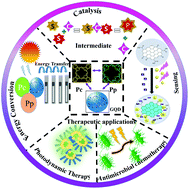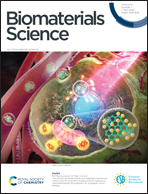Graphene quantum dot-porphyrin/phthalocyanine multifunctional hybrid systems: from interfacial dialogue to application
Abstract
Engineered well-ordered hybrid nanomaterials are symbolically at a pivotal point, just ahead of the long-anticipated transformation of the human race. Incorporating newer carbon nanomaterials like graphene quantum dots (GQDs) with tetrapyrrolic porphyrins (Pp) and phthalocyanines (Pc) is crucial for achieving exquisite molecular nanoarchitectures that are superior to their individual components. The outcomes of this, particularly in the case of graphene quantum dot-porphyrin/phthalocyanine (GQD-Pp/Pc) hybrids, remain comprehensively unexplored to date. Interestingly, GQD-Pp/Pc hybrids provide a modern strategy to regulate matter by utilising intramolecular and organisational properties to create well-defined nanocomposites via a synergistic enhancement effect. The high molar absorption coefficient and enhanced energy transfer, hole and electron transfer abilities capabilities allow Pp and Pc to exhibit a wide spectrum of photophysical and photochemical features. However, their low biostability, non-specific tumor-targeting properties, hydrophobicity, and low cellular internalisation efficiency limit their extensive biomedical utility. Conjugating Pp/Pc to nanocarriers such as GQDs improves their targeted delivery, immunological tolerance, and longevity. Due to the zero-order release kinetics of GQDs, they can assist in maintaining a steady rate of photosensitiser (PS) delivery at the desired site. To completely rationalise the functionalization of GQD-Pp/Pc species at interfaces, we investigate the current prominence and future potential of porphyrin-related graphene nanosystems, especially GQDs, for the development of various applications. This encouraging report demonstrates how GQD-Pp/Pc species can be used to examine new phenomena at the multidisciplinary level. Notably, a customised hybrid system optimises amendable and diverse functional properties, yielding a ray of hope in the fields of photodynamic therapy (PDT), photocatalysis, solar cells, sensing, and beyond via various photo-physicochemical approaches such as electron transfer, catalytic transformation, light-harvesting, and axial/peripheral ligation of adducts. Gratifyingly, the covalent and non-covalent coupling of functional molecular units at interfaces enable new properties to be generated in hybrid systems.



 Please wait while we load your content...
Please wait while we load your content...